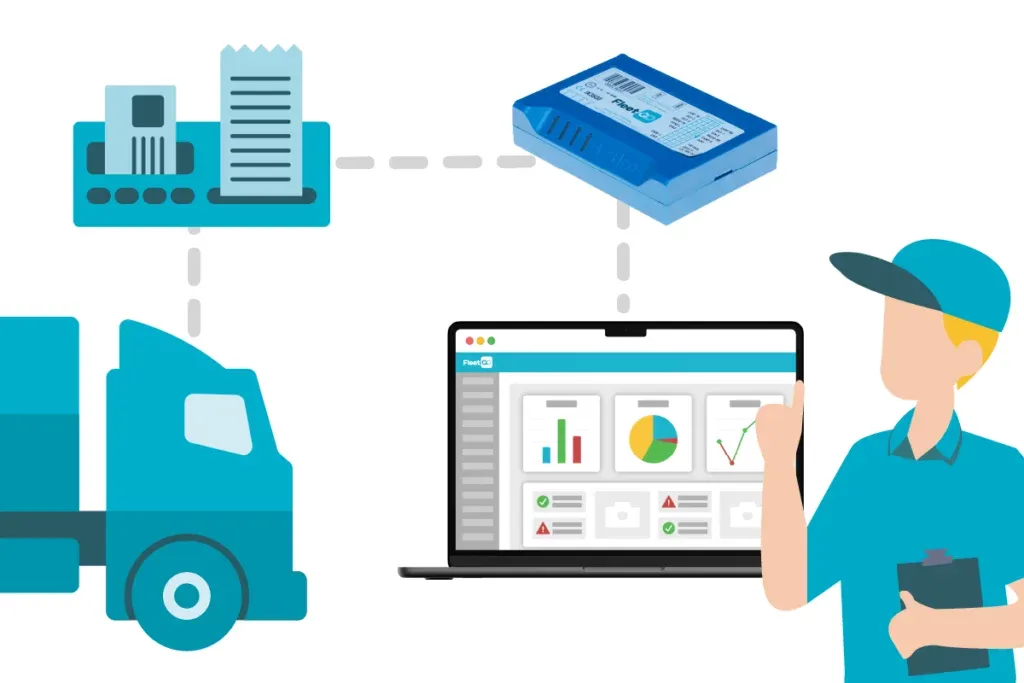Telematics is a word that comes up often when dealing with modern fleet management, but there can be confusion around the actual meaning of this word and why it is so crucial to good fleet management.

The meaning of telematics is simply a convergence of information processing and telecommunications, and it is a word that has significance in many industries. In practical terms, it is the use of various communication mechanisms to transmit a wealth of data, such as transmitting the location of a vehicle — obtained using a GPS tracker — back to the depot using a cellular network.
In a fleet environment, the implementation of telematics is undeniably useful, as it allows fleet managers to have access to a huge range of live data they can download regarding their vehicles.
What Is a Telematics System?
While the core definition of what telematics means is unchanged in a fleet context, certain things have come to be associated with vehicle telematics specifically. For example, this includes features related to vehicle collisions, such as automatic detection and SOS functions.
A vehicle telematics system is, at its core, a suite of telematics devices and software. A fleet vehicle can send everything from its location to the temperature of the goods being transported. All of this information is transmitted wirelessly back to the depot, where a fleet manager can use a software dashboard to keep tabs on everything happening across the entire fleet.
Telematics systems are very adaptable, as the information collected and transmitted can be unique — not just from organisation to organisation but from vehicle to vehicle. If a company transports perishable food, they might choose to have temperature sensors installed in a vehicle that transports food. A vehicle that transports non-perishable goods, which aren’t sensitive to temperature changes, would not need such a sensor. Still, they may benefit from other kinds of information.
Common Features of Telematics Systems for Vehicles
As mentioned above, telematics for fleets has come to be associated with specific features. Some of the most common are listed below.
Automatic collision detection
Modern vehicles have a number of ways to detect a collision, and that information is available to the telematics system in most cases. It can be used to automatically notify fleet management of the incident and even summon help directly. The technology used to achieve this is built to withstand severe accidents, so it should still work, even in the event of a bad crash. In addition to being useful for police records, this feature can literally save the lives of drivers and other road users.
Roadside assistance
Not all vehicle problems happen due to road collisions. As much as maintenance schedules are adhered to, it is still possible for vehicles to break down. It could be a flat tyre, running out of fuel or an unexpected mechanical failure. When this happens, telematics can ensure help arrives as quickly as possible.
Vehicle diagnostics
Regular vehicle condition reports help fleet managers take proactive action to keep their vehicles healthy. Maintenance schedules are a good start, but telematics enables fleet managers to see when a vehicle needs attention outside of regular service intervals.
Emergency assistance
Not all emergencies are related to a vehicle collision. It is common to have an emergency assistance feature in a fleet telematics system, which allows for quick and convenient access to emergency services.
”Good Samaritan” assistance
This feature allows drivers who spot others in need of assistance to get emergency assistance sent out to them quickly. It’s often as simple as just pressing a button.
Cargo monitoring
A host of sensors can be installed in the cargo area of a vehicle, including temperature sensors and humidity sensors. This not only helps to keep the transported goods remain safe and in good condition, but it also makes it easier to stay compliant with various regulations. For example, laws regarding the storage and transportation of food.
What Are the Benefits of a Telematics System?
There are many benefits to fleet telematics, the most notable of which are listed below.
Safety
One of the more notable benefits of telematics is increased safety for the driver, the vehicle and any goods being transported. As mentioned above, there are various ways in which telematics systems make it easier for a driver to call on emergency assistance and even automatically request assistance in the event of a collision.
Cost reduction
The wealth of data collected by telematics can be used to analyse driver behaviour and route performance. The insight gained from this often brings down costs by improving fuel economy and optimising driver routes. Route planning can also take live traffic data into account, enabling drivers to avoid traffic jams and other problems, such as road closures.
Maintenance
Service schedules don’t need live data to be adhered to, as a simple calendar-based reminder will usually suffice. That being said, problems can still crop up with vehicles, even if they are properly inspected and serviced at the correct intervals. Telematics systems can monitor things like fuel consumption, tyre pressure, engine load or temperature and more. This information can be used to catch problems in their infancy, allowing a fleet manager to pull a vehicle in for attention before any issues become more serious.
Visibility
One of the most common features of these systems is GPS tracking. Tracking telematics enables fleet managers to track the whereabouts of their vehicles at all times. The benefit of this ability includes being able to find a vehicle that has been stolen, checking on the progress of a driver and making route corrections in real time.
Compliance
UK law requires various records to be kept, such as driver hours. Having everything be electronic and automatically transmitted back to the fleet management software solution makes it easier to stay in compliance with such regulations. Automatic notifications can also be set up for when drivers approach their limits, and software can even disregard drivers for certain jobs if it would likely take them over their allowed hours.
Conclusion
The telematics definition may seem to be a little muddied when dealing with a fleet, as it is often used interchangeably with fleet management. A simple way to think about telematics is that it is the mechanism by which fleet management software gets its information in the first place. Going forward, it is likely that the scope of fleet telematics will continue to expand. Sensors are becoming smaller and cheaper, connectivity is increasing, and data speeds are getting faster — all of this makes it possible to track even more information. AI (artificial intelligence) is also likely to play an increasing role in telematics. Large amounts of data are undoubtedly useful, but gaining insight from that data can be difficult without the potential of AI-powered technology.
Disclaimer
This content is provided for informational purposes only and is not meant to be an endorsement or representation by FleetGO.com or any other party. This information may contain inaccuracies or typographical errors, despite our efforts to ensure accuracy. FleetGO.com accepts no responsibility or liability for any errors or omissions, and is not responsible for the contents of any linked website or any link contained in a linked website. Please refer to our full disclaimer for more details.


